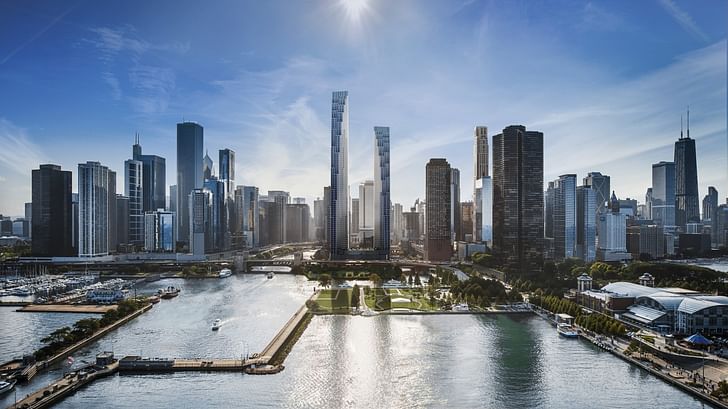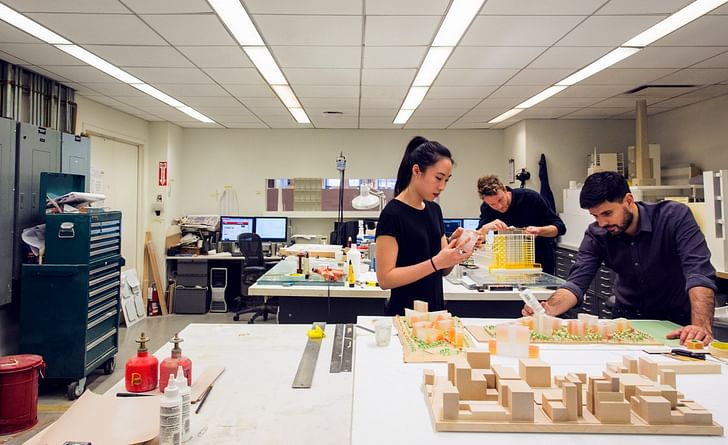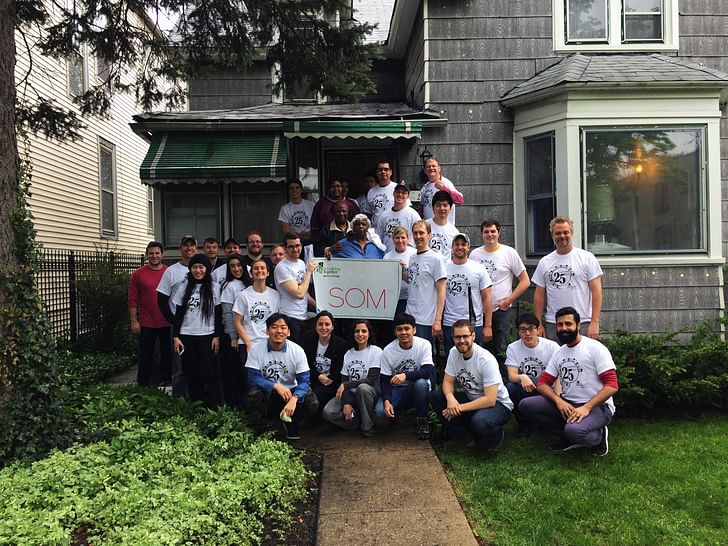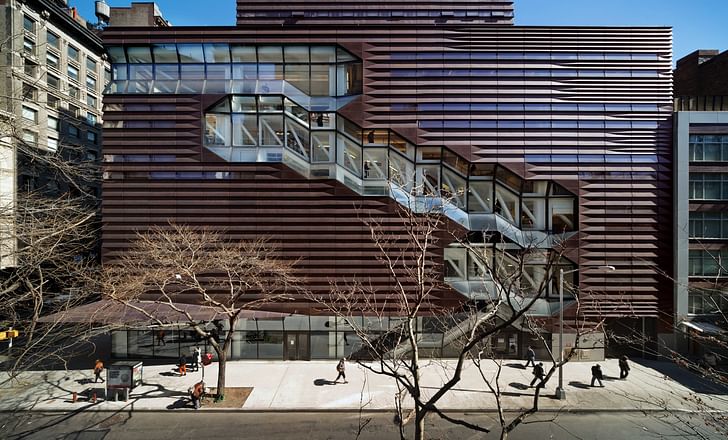

Skidmore, Owings, & Merrill has carried out their pioneering spirit since the firm was established over 80 years ago — from developing Architectural Engineering Systems and building record-breaking skyscrapers worldwide, to their multiple AIA Twenty-Five Year Awards and their “Year One” initiative that fosters new talent.
As one of the most established architecture firms out there, what does SOM expect from job applicants when it's time to hire new employees? In Archinect's latest “How To Get A Job At ____”, SOM Partner Carrie Byles got in touch with us to share some tips — including the most common mistake applicants make (the answer is simpler than you think) — and a glimpse into the firm's office culture.
1. What positions are most in-demand at SOM?
We are always looking for talented people at all levels. While many of our new hires are recent grads, we’re also focused on recruiting design professionals with 7 to 10 years of experience. We have a very diverse community with people from a broad range of backgrounds which contributes greatly to the richness of our conversations and ideas.
2. SOM has recently announced a new initiative called Year One that seems to bridge the gap between school and professional practice. Can you talk about this new program, and how you recruit for it?
We were inspired to develop Year One through conversations with recent hires, especially those who went through our internship program. We know that new graduates have a lot to contribute, and we want to give them the resources to build their careers from their very first day at SOM.
We call Year One an “accelerator” program—it’s designed to provide exposure to all aspects of the practice. In parallel with their project-based work, our new hires will expand their learning through a range of activities, from site visits to educational seminars. We’ll also support our new staff as they work toward the next milestone in their careers: earning their professional license.
We are recruiting through our existing relationships with schools and also building new relationships with schools that have professional programs in architecture, engineering, interior design, urban design, and sustainable design.


3. When meeting with a candidate, what are some ways that they can make a positive first impression during the interview?
We interview a lot of candidates who are just out of school or have very little experience. Those who are able to communicate their passion and creativity for the profession will set themselves apart. Enthusiasm is more important than experience—our new hires will be learning and growing with us.
Enthusiasm is more important than experience—our new hires will be learning and growing with us.
4. What do you want to learn most about the candidate during the interview?
We’re looking to see how each candidate will collaborate within our collective practice. It is important not just to contribute as an individual, but to understand how each person’s effort makes a more successful team.



5. What is the most common mistake that candidates make when applying to your firm?
Candidates often fail to submit a complete job application, including a considered portfolio that fully represents their passion and talent. This is the first opportunity to make an impression—it should go without saying that every detail counts.
6. What makes a strong CV/portfolio?
A good portfolio is clear, legible, and succinct. It’s better to let the work speak for itself rather than rely on a lot of written description. The ability to self-edit is important.
7. How important is an applicant's educational background?
We require professional degrees; the school does not make a difference. Having individuals from a range of educational backgrounds expands the diversity of perspectives within our firm.


8. What kind of training do new hires undergo when they first start?
Year One will provide an experience that goes far beyond the usual on-the-job training. The program offers a wealth of opportunities to learn—mentorship, licensure support, professional education, community involvement, and more.
We provide all of our employees with ongoing learning opportunities such as software training, lunchtime seminars on a variety of industry topics, and an evening lecture series. With so many experts within our firm—leaders in digital design, high-performance environmental design, building enclosures, and more—new hires will perhaps learn most of all directly from their colleagues.
9. Do you have an internship program? If so, briefly describe.
Our internship program is well established and quite competitive. Every year we receive hundreds of applications for perhaps 20 spots per office. The structure of our internship program helped to inspire Year One. Both programs provide an immersive introduction to the way we work. We lead our interns on site visits, host in-house lectures, and give detailed presentations on projects. These educational initiatives, combined with the quality and range of our design work, make SOM an incredible place to learn—especially for those just starting their careers.



10. What are three words that your employees might use to describe your firm?
Collective. We bring together diverse voices and perspectives. Collaboration between disciplines defines the way we work.
Incubator. A spirit of inventiveness has always defined our firm. For those seeking the leading edge of digital design and new technologies, SOM is the perfect place to “geek out.”
Opportunity. When you join SOM, you become part of a more-than-80-year regenerating and evolving legacy. Any exceptionally talented individual who joins SOM may lead the firm one day. With our incredible clients and resources, SOM is a powerful platform and accelerator to achieve your highest design and professional aspirations.


11. What additional social activities do you do as an office?
Our offices host summer and holiday parties, along with other social events. We have a range of intramural sports activities—softball and cricket teams, running and sailing groups. Most importantly, we’re engaged in the industry and in our communities. Our staff volunteer their time with the ACE Mentor Program and the Spark Program, among other philanthropic initiatives. We often lend our expertise to projects in our local communities through programs such as Habitat for Humanity and National Rebuilding Day.

12. If a candidate had the choice between you and another firm, what argument would you use to win them over?
SOM has a greater diversity of projects than most other firms. Our work ranges in scale from supertall towers to small education projects. Along with this comes a greater depth of resources to invest in exploration and research. Because we operate as one firm in all regions of the world, our staff are plugged in to a global knowledge sharing network. In short, we’re able to provide many opportunities that other firms cannot. I would also add that SOM is rare in that it is a large, global firm that emphasizes design in the way that a much smaller, boutique firm might. The firm manages to walk the line between being a design firm, first and foremost, and having tremendous technical and management capabilities. I don’t think many other firms can claim this.
Interested in joining SOM? Check out their Archinect profile to see if they have any current listings. To see more active listings from hundreds of firms, browse Archinect's Job Board.
5 Comments
quote from one of my SOM colleagues "SOM is like a high-class sweatshop"
Offcourse they are looking for naive enthusiastic employees who will lose 3 years of their lives suffering from over time, anxiety and depression.
I went to SOM directly from school, way back in 1986. Even though the programs offered for young architects are more robust and versatile today, I had the most extraordinary 7-year experience at SOM where I was exposed to every facet of the industry. I'll always be indebted to the mentors I had there and the deep and diverse experience the firm has. To me, SOM is the Google of the AE space.
The article is nonsense; you want to know the real SOM; work in the Chicago office; the other offices aren't SOM as I was told by others in the Chicago office when I worked in Chicago. Look at the pictures; most are young and work long hours of overtime. I worked so much overtime that the NCARB refused to log in my hours because they thought it was impossible for anyone to work that way. When I was in Chicago, the firm had 1000 and laid off about 800; there's job security for you. I was still there; they said I had excellent reviews when finally let go, but the decisions was because the other guy had family and I was single; so the decision had nothing to do with WORK. All this talk about work . No severance, out the door. References anyone? LOL. And I trained the company; when they needed a 25 foot section on the buildings through a trains station for the engineers; I did it, with no training, only because I was that good. My real training came from a smaller company I worked for before. I never learned anything from any supervisor at SOM. I asked the right questions, I checked the drawings correctly, and I did the details. In Europe the architecture licensing is immediate from school, here you needed the intern program; in Chicago everyone got licensed in Wisconsin since there was no need for internship. When I worked there, people that I hardly knew showed up for jobs; when I left, the same people wouldn't take my call. References anyone? but look at all my 10 star reviews? References anyone? The word enthusiasm is poorly placed; the better word are motivation and to be fully invested; so they hired mostly people with masters degrees when I was there. The results are tenuous; maybe 1 out of 100 really cared about what they were doing and the rewards for that at best were non existent because people are human and filed with biases that obscure the truth. Even with 10 star reviews you will be overlooked because of personal biases. nobody wants it that good. And coworkers don't care for it either. The randomness of that makes the partners clueless to the actual working environment and goings on.
Wow so humble
Back in 07' right after I received my M.Arch degree, I started my arch career in the SF office. Hours were long, I learned a lot. Worked on mostly high rises, mostly in China. Currently I am working on Chinese hotel projects for another firm. There were a few all nighters, redlines, crashing renders, early versions of evit crashing on printing out a set. Sometimes you have to do what what it takes until the oxygen runs out(they would turn off the HVAC at 1 Front after 6 it seemed) it made long nights even longer - like working with your mask on.
Block this user
Are you sure you want to block this user and hide all related comments throughout the site?
Archinect
This is your first comment on Archinect. Your comment will be visible once approved.